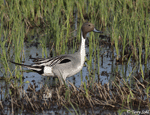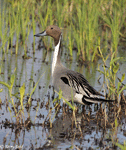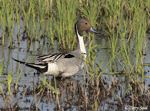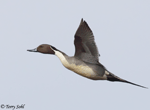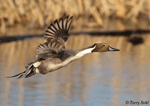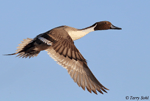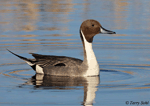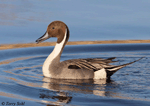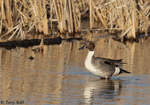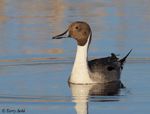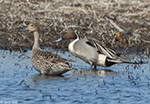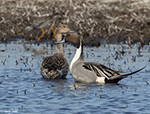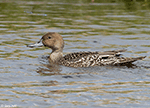| Length: 20 to 26 inches | Wingspan: 28 to 36 inches | Seasonality: Summer |
| ID Keys: Brown head with white stripe near back (male), gray body, long tail | ||
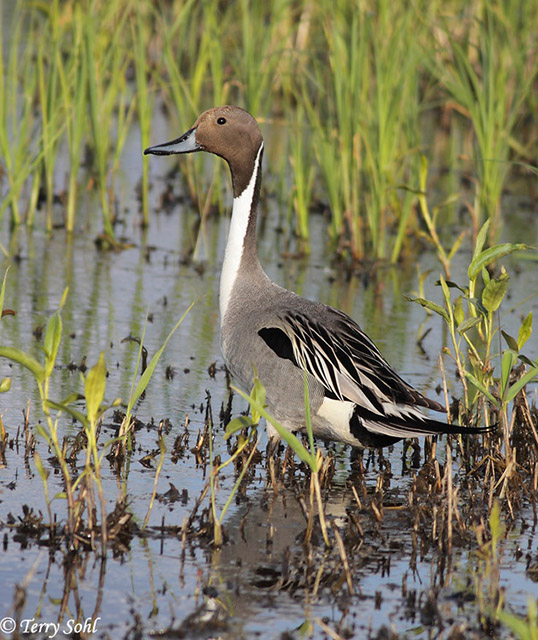 The Northern Pintail is
one of the most widespread and common ducks in the world, and is found in Europe
and Asia as well as North America. The are one of the larger duck species
found in South Dakota, and with the long tail of the males, the very long neck,
and the elegant plumage, they are distinctive if seen well. One of the most wary
waterfowl species, Northern Pintails can be very difficult to approach in all
seasons, taking flight at the first indication of danger.
The Northern Pintail is
one of the most widespread and common ducks in the world, and is found in Europe
and Asia as well as North America. The are one of the larger duck species
found in South Dakota, and with the long tail of the males, the very long neck,
and the elegant plumage, they are distinctive if seen well. One of the most wary
waterfowl species, Northern Pintails can be very difficult to approach in all
seasons, taking flight at the first indication of danger.
Habitat:
Marshland and shallow lakes or ponds with emergent wetland vegetation. Nests are in dense vegetation growth, often very near water but sometimes up to half a mile away from the nearest water source.
Diet:
A variety of items, but mostly plant material and insects. The winter diet is largely plant material, especially seeds, roots, and waste grain. Insects and the occasional mollusk, crustacean, or small fish become a significant part of the diet in the summer.
Behavior:
Forages by dipping its head below the surface in shallow water, finding the majority of its food in the mud bottom beneath the water. Northern Pintails will also often forage on land, waddling along the ground in search of food items.
Nesting:
April through June in South Dakota. The nest of a Northern Pintail is a scrape on the ground, lined initially with grasses and other vegetation, but typically lined with down. The nest is placed in vegetated cover, which may be grasslands, wetlands, or even cropland, sometimes relatively far from water (further than most other dabbling duck species). The female lays between 3 and 12 eggs, and she alone incubates them. The young hatch after about 24 days.
Song:
Males give a subdued whistling call, often given while in flight. Females give a wavering quacking call, particularly if disturbed.
- Click here to hear the flight call of a Northern Pintail1
- Click here to hear the quacking call of a female Northern Pintail2
Migration:
Summers through the northern half of the U.S., Canada, and Alaska. Winters throughout much of the southern half of the U.S., and U.S. and Canadian coastlines. On rare occasions a straggler may attempt to overwinter in South Dakota.
Interactive eBird Map:
Click here to access an interactive eBird map of Northern Pintail sightings
Similar Species:
The male is generally quite distinctive, while the female can look similar to many dabbling ducks. The best clue to identify females is sometimes to look at their partner male birds, given how dabbling duck species are often found as "couples". Otherwise, here are some identification clues:
- Blue-winged Teal - One of the most common duck species in South Dakota, Blue-winged Teal are often found intermingling with Northern Pintails. As noted above, males are easy to tell apart, but females are very similar in overall appearance. While female Northern Pintails may lack the long trademark tail of the males, they do have a longer tail than a Blue-winged Teal female. Northern Pintail females also tend to be a little darker on the head and face than a female Blue-winged Teal. However, these ID characteristics are often difficult to rely on if a single female bird is seen in isolation from its mate. Reliable identification is often still reliant on seeing the birds in their mating pairs.
- Gadwall - Gadwall females have a distinctive and strong "chevron" pattern on their flanks that's much less distinct on a female Gadwall. Female Gadwalls also have a shorter neck compared to a Northern Pintail female (an identification feature that's really only obvious if the bird's neck is extended). Bill color is perhaps the easiest way to differentiate the two, as female Gadwalls have a blackish orange bill, while the bill on a female Northern Pintail is black. Given the relatively plain colors of a male Gadwall, they too could potentially be confused with a female Northern Pintail if not seen well. The very fine vermiculated patterns on the flanks of a male Gadwall separate it from the broader, bold chevron patterns of the female Northern Pintail. Male Gadwalls also have a distinct black patch near the rump that's lacking from female Northern Pintails.
- Mallard - Female Mallards have an orangish bill, compared to the black bill of a Northern Pintail. A bluish wing patch is often visible on a female Mallard (depending upon posture and wing position). Female Mallards also have a shorter neck than a female Northern Pintail, and a stronger head pattern with a darker crown.
- Green-winged Teal - Female Green-winged Teals are substantially smaller than a female Northern Pintail, with a shorter neck and a darker contrasting crown that's lacking from a female Northern Pintail.
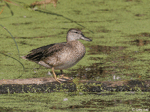 |
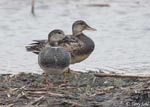 |
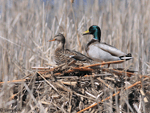 |
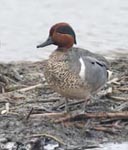 |
| Blue-winged Teal | Gadwall | Mallard | Green-winged Teal |
Conservation Status:
Northern Pintails have an extremely large geographic range, found not only in North America but in Europe and Asia as well. They are still relatively common in some parts of that range. However, surveys show they have declined significantly in many areas of North America since the 1950s. With the large overall population size and geographic range, however, the IUCN still considers the Northern Pintail to be a species of "Least Concern".
Further Information:
Photo Information:
May 14th, 2010 - Kingsbury County, South Dakota -- Terry L. Sohl
Additional Photos:
Click on the image chips or text links below for additional, higher-resolution Northern Pintail photos.
Audio File Credits:
- 1Marco Dragonetti. Recorded on the coast of Italy on February 23rd, 2015. Original recording and information from xeno-canto.
- 2Jens Kirkeby. Recorded in Russia on June 16th, 2017. Original recording and information from xeno-canto.
| Click on the range map for a higher-resolution view |
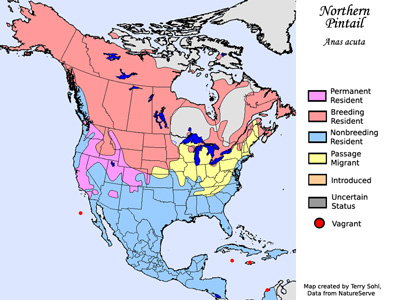 |
| South Dakota Status: Common migrant and summer resident throughout the state. Rare in winter. |
Additional Northern Pintail Photos
Click for a higher-resolution version of these photos
